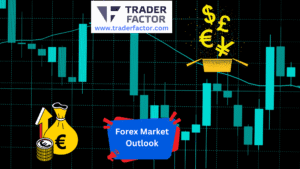Global financial markets faced intensified volatility on Monday, with U.S. indices experiencing steep declines at the open amid rising trade tensions and fears of a global economic slowdown. The Dow plunged 1,700 points before recovering to close 0.9% lower, while the S&P 500 and Nasdaq saw similar intraday swings, underscoring fragile investor confidence. Escalating U.S.-China tariff disputes have heightened uncertainty, leaving markets vulnerable to abrupt swings. Looking ahead, the release of FOMC minutes, as well as CPI and PPI reports, will be critical in shaping market sentiment and shedding light on inflation pressures and future monetary policy decisions.
Table of Contents
ToggleEarly Market Performance and Intraday Declines
The trading session began with substantial drops across the board. The Dow Jones Industrial Average briefly plunged 1,700 points before regaining some ground, ultimately closing 0.9% lower at 37,965.60. Similarly, the S&P 500 fell 4.7% during early trading, hitting its lowest level in over a year. It managed to narrow losses, ending 0.2% lower at 5,062.25. Meanwhile, the tech-heavy Nasdaq witnessed an intraday decline of 5.2%, yet it closed marginally higher, up 0.1% at 15,603.26. These swings reflected deep investor unease as traders reacted to conflicting news around potential tariff modifications.
The stark intraday declines were reminiscent of past market crises, stirring parallels to episodes of sudden economic shocks. However, the percentage loss at market open was notably less severe than historical crashes like Black Monday in 1987. Still, the rapid deterioration and partial recovery illustrated the current sensitivity of markets to policy-related uncertainties.
Trade Tensions Drive Volatility
The sharp sell-off was fueled by escalating fears over U.S.-China trade relations. Over the weekend, Trump reiterated plans to impose further tariffs on Chinese imports, worsening the already strained ties between the two largest economies. The threat of additional levies prompted widespread concern over disruptions in global supply chains and slower economic growth.
An erroneous news report early in the session suggested a potential 90-day pause on tariff implementations. This brief flicker of optimism triggered a mid-day rally in major indices. However, subsequent rebuttals from the White House dashed hopes for a reprieve. Tariff increases remained on the table, amplifying uncertainty and prolonging market disarray.
Such mixed messaging added to the complexity of investment decisions, as traders struggled to assess the long-term impact of protectionist policies. While some sectors like technology showed relative resilience due to targeted risks, others, such as real estate and manufacturing, bore the brunt of investor concerns.
Gold and Bitcoin Reflect Investor Sentiment
Amid the turbulence, traditional safe-haven assets displayed a mixed performance. Gold prices dipped 1.42% to settle at $3,015.70 per ounce after earlier touching highs. Profit-taking activities and a slight rebound in the U.S. dollar contributed to the metal’s drop. Despite this decline, analysts believe gold’s year-to-date gains of 13% underscore its continued appeal as a hedge against economic uncertainty.
Cryptocurrencies, meanwhile, attracted risk-seeking investors looking for alternative assets. Bitcoin climbed 1.92%, nearing $79,562.19, signaling bullish sentiment in decentralized platforms. Market participants viewed this movement as a sign of the growing diversification of portfolios amid conventional market instabilities.
Broader Impacts and Looking Ahead
The day’s events highlight the precarious state of global trade and the interplay between policy decisions and market reactions. Beyond equities, bond yields also experienced notable shifts, with the 10-year Treasury yield rising to 4.16%. This spike reflected divergent views on risk, as some investors prepared for potential inflationary pressures while others sought safety.
Looking forward, the market remains on edge as speeches from Federal Reserve officials and consumer price data are anticipated later this week. Together, these factors will shape short-term expectations for economic growth and monetary policy adjustments. Still, until more clarity materializes on the trade front, financial markets are likely to remain unpredictable.
Market Outlook for Tuesday, Tarrif Effects to Continue
With no major economic or policy events scheduled for Tuesday, market dynamics are likely to remain shaped by ongoing trade tensions initiated by President Trump’s tariff measures. The uncertainty surrounding U.S.-China relations continues to weigh heavily on investor sentiment, creating a delicate environment across asset classes. Although the market showed signs of stabilizing after Monday’s sharp declines, volatility could persist amid the fragile confidence of global investors.
Stocks Likely to React to Tariff Concerns
Equity markets may experience subdued momentum as participants digest Monday’s turbulence. The Dow Jones, S&P 500, and Nasdaq could remain sensitive to updates, particularly those related to new U.S. trade tariffs or China’s potential countermeasures. Persistent fears over supply chain disruptions and their broader economic impact are expected to dominate the outlook for sectors like manufacturing, technology, and consumer goods.
Investor attention may also shift toward potential sectoral rotation, as defensive plays like utilities and healthcare attract risk-averse funds. The lack of clarity around trade policies adds to the challenge of estimating corporate earnings resilience, keeping market participants cautious.
Commodities Under Mixed Influence
The commodities market may witness additional pressure as trade restrictions continue to pose challenges for global trade flows. Gold, which typically acts as a hedge in uncertain times, could remain under scrutiny following Monday’s selloff. Analysts expect fluctuations around the $3,000 mark due to competing forces of safe-haven demand and profit-taking.
Meanwhile, industrial commodities such as copper and crude oil could react negatively to lowered global growth forecasts and costlier trade implications. Markets may also factor in the U.S. dollar’s movement, as its strength makes commodities priced in dollars less appealing for international buyers.
Forex Markets Eye the Dollar’s Strength
The foreign exchange market is expected to mirror the broader climate of uncertainty. The U.S. dollar strengthened on Monday, bolstered by its safe-haven appeal amid global economic concerns. If trade-related anxieties persist, currency traders may continue to favor the dollar, putting pressure on major currency pairs like EUR/USD, GBP/USD, and AUD/USD.
Conversely, currencies tied to export-dependent economies, such as the Australian and Canadian dollars, may face additional headwinds. These nations are highly exposed to global trade disruptions, making them particularly vulnerable in the current environment. Structural weaknesses in other major economies, combined with heightened volatility, may exacerbate the forex market’s risk-off behavior.
Market Outlook for Wednesday
Wednesday, is set to be a pivotal day for global financial markets as several key events, spread over different time zones, could influence market sentiment and asset valuations. From New Zealand’s RBNZ rate statement to the release of FOMC Meeting Minutes in the U.S., traders will closely watch the potential implications for equities, forex, commodities, and cryptocurrencies. Expectations are high for these events to shed light on monetary policy directions and broader economic trends.
RBNZ Rate Statement and Its Impact
New Zealand’s Reserve Bank is set to release its interest rate decision on Wednesday, a critical event for the New Zealand dollar (NZD) and regional markets. Analysts currently expect the central bank to hold rates steady, given indications of moderate inflation and stable economic growth. However, comments about future monetary policy could create significant volatility in the NZD/USD pair.
Should the RBNZ signal any inclination toward further monetary tightening to control inflation, this could prompt a rally in the New Zealand dollar and spill over to other risk-sensitive currencies. Conversely, dovish commentary may weigh down the currency, leading to a potential outflow of capital into safe-haven assets. This event will provide insight into how smaller advanced economies are navigating global economic headwinds in 2025.
BOJ Governor Ueda’s Speech
Later in the day, Bank of Japan Governor Kazuo Ueda is scheduled to address the economic outlook and monetary policy. Given Japan’s persistently low inflation and a prolonged period of easing, Governor Ueda’s remarks could offer guidance on whether the BOJ plans to maintain its ultra-loose stance or consider gradual adjustments.
The yen is likely to take cues from any unexpected signals of policy tightening, although markets generally expect the BOJ to remain accommodative. A stronger yen could have implications for Japanese exporters, with potential ripple effects reaching equity markets, particularly Japan’s Nikkei 225 index. Global investors will listen for hints about inflation targets, growth challenges, and fiscal coordination efforts in this speech.
China New Loans Report
China’s New Loans report, a monthly indicator of credit expansion, will also be closely monitored, especially for its implications on the Australian dollar (AUD). Australia’s economy is highly interconnected with China’s due to the latter’s demand for commodities such as iron ore and coal. A report showing robust credit growth in China could signal stronger economic activity, potentially boosting the AUD against major peers.
However, weak lending data might reinforce concerns about a slowdown in China’s economic recovery in 2025, applying pressure on commodity-linked currencies. Global equity markets may also react, particularly if the data fuels concerns over reduced trade activity or weaker demand for raw materials. Commodities such as copper and crude oil are similarly set to absorb the impact, trading in line with shifting market expectations.
FOMC Meeting Minutes
The centerpiece of the trading day will occur during the New York session as the U.S. Federal Reserve releases its minutes from the latest FOMC meeting. These minutes are expected to offer critical insights into the central bank’s near-term views on inflation, employment, and economic activity, all through the lens of its monetary policy framework.
If the minutes reveal a continuation of hawkish sentiment, with policymakers leaning toward further rate hikes, equities may face renewed pressure due to rising borrowing costs and tightened financial conditions. Conversely, signs of a pause in tightening could support risk assets and weaken the U.S. dollar. Commodities such as gold and oil may react accordingly, with gold particularly sensitive to any dovish tones, which could ease real yields and support its safe-haven appeal.
Forex markets will also be highly reactive. Pairs like EUR/USD and GBP/USD could see sharp moves depending on how the dollar responds to the policy tone. Cryptocurrencies, which recently benefited from dollar weakness, may see changes in momentum if the Fed shifts its stance or offers unexpected guidance.
Market Outlook for Thursday
Thursday brings an important set of economic data and central bank commentary, shaping the trajectory for global financial markets. With China’s CPI and PPI reports, Australia’s RBA Governor discussing monetary policy, and the U.S. releasing key inflation data and unemployment claims, the day is expected to influence investor sentiment across equities, forex, commodities, and cryptocurrencies. The outcomes will help gauge inflationary pressures and monetary policy strategies globally.
China’s CPI and PPI Reports
China’s Consumer Price Index (CPI) and Producer Price Index (PPI) are pivotal for understanding the inflationary and industrial price dynamics of the world’s second-largest economy. The CPI provides insight into consumer-side inflation, while the PPI reflects the cost pressures faced by producers.
Higher-than-expected CPI data could signal increased domestic demand and inflation, influencing policy expectations for China’s central bank. This could lead to increased volatility in the Chinese yuan and also impact commodity markets, as stronger data often boosts demand for raw materials. Conversely, weaker PPI figures could indicate shrinking industrial profitability and slower manufacturing growth, adding pressure to commodity-linked currencies such as the Australian dollar. Traders will closely monitor how these figures align with existing concerns over China’s economic stability in 2025.
RBA Governor’s Monetary Policy Speech
Following China’s data, market participants will turn their attention to remarks from Australia’s Reserve Bank (RBA) Governor during his monetary policy speech. Recent trends in inflation, employment, and global demand will likely dominate the discussion.
A hawkish tone, hinting at further rate hikes to rein in inflation, could boost the Australian dollar, especially in light of its correlation with China’s economic health. On the other hand, dovish rhetoric could weigh on the currency and shift investor interest toward Australian equities or safer assets like bonds. The speech will also provide context on how Australia is handling global economic challenges, including trade disruption and supply chain concerns, offering a broader outlook for the region’s financial markets.
U.S. Inflation Data and Unemployment Claims
The main focus in the New York session will center on the U.S. inflation figures (Core CPI m/m, CPI m/m, and CPI y/y) and weekly unemployment claims. Inflation data is expected to influence the Federal Reserve’s next policy moves, making it critical for all asset classes.
Higher inflation outcomes could reinforce expectations of further Fed tightening, potentially pushing U.S. Treasury yields higher and pressuring growth-sensitive equities. At the same time, the U.S. dollar could strengthen, putting downward pressure on commodities like gold and crude oil. Conversely, weaker CPI readings may support the expectation of a pause in rate hikes, fostering a risk-on sentiment that could benefit equities and weigh on the dollar.
Weekly unemployment claims will provide additional insight into labor market conditions. A low claims number would suggest continued tightness in the labor market, adding to inflationary pressures. By contrast, higher claims could indicate slowing hiring activity, which might ease concerns over wage-led inflation. Given the interplay between inflation and employment in guiding Federal Reserve policy, both data sets will be carefully scrutinized.
Market Outlook for Friday
Friday, April 11, 2025, marks an important day in financial markets as critical economic data from the UK and the U.S. comes into focus. Britain’s GDP m/m report, combined with U.S. inflation and sentiment data, could significantly shape market sentiment across multiple asset classes. Investors will analyze these reports to track economic resilience, inflationary pressures, and consumer confidence as key drivers of global financial trends.
Britain’s GDP m/m Data
The United Kingdom’s GDP m/m release will be closely watched as it provides a snapshot of monthly economic performance. Market participants will scrutinize this figure for signs of growth amid ongoing economic challenges, including inflationary pressures and potential trade disruptions due to shifting global dynamics.
Strong growth data could bolster the British pound (GBP), signaling resilience in the UK economy and renewing interest in UK equities. This might particularly benefit sectors linked to domestic demand, such as retail and manufacturing. Conversely, weaker-than-expected growth could increase concerns about stagnation and pressure the GBP against other major currencies, especially the U.S. dollar. Investors will also keep an eye on how this data aligns with the Bank of England’s monetary policy stance, particularly in the face of persistent inflation.
U.S. Core PPI and PPI Reports
Key inflation data in the form of U.S. Core Producer Price Index (PPI) m/m and PPI m/m reports will dominate the early U.S. session. Producer price inflation serves as an upstream indicator of broader consumer price trends, making it a valuable component for anticipating Federal Reserve policy decisions.
Higher PPI figures are likely to reinforce expectations of additional policy tightening from the Federal Reserve, potentially pushing U.S. Treasury yields higher and dampening risk sentiment in equity markets, particularly for growth-driven sectors like technology. A strong Core PPI reading could also lend support to the U.S. dollar, dampening commodities such as gold and crude oil due to their inverse correlation to the currency. On the other hand, softer PPI data might ease inflationary concerns, bolstering equity markets and contributing to dollar weakness as traders begin pricing in a pause in rate hikes.
Prelim UoM Consumer Sentiment and Inflation Expectations
The University of Michigan’s preliminary readings on Consumer Sentiment and Inflation Expectations will also play a pivotal role. Consumer sentiment gauges remain critical in assessing the overall economic outlook, given that consumer spending accounts for a significant portion of U.S. economic activity.
A stronger-than-expected sentiment reading could enhance confidence in the strength of the U.S. economy, supporting equities and dampening safe-haven demand. This would likely provide additional momentum to cyclical stocks and further bolster the U.S. dollar. Inflation Expectations, on the other hand, will be closely examined for clues about how consumers perceive price pressures. Persistently high expectations might reignite fears of prolonged inflation, pressuring the Federal Reserve to maintain a hawkish tone. Weaker expectations could signal that ongoing monetary tightening is beginning to weigh on inflationary dynamics.
Disclaimer:
All information has been prepared by TraderFactor or partners. The information does not contain a record of TraderFactor or partner’s prices or an offer of or solicitation for a transaction in any financial instrument. No representation or warranty is given as to the accuracy or completeness of this information. Any material provided does not have regard to the specific investment objective and financial situation of any person who may read it. Past performance is not a reliable indicator of future performance.

















